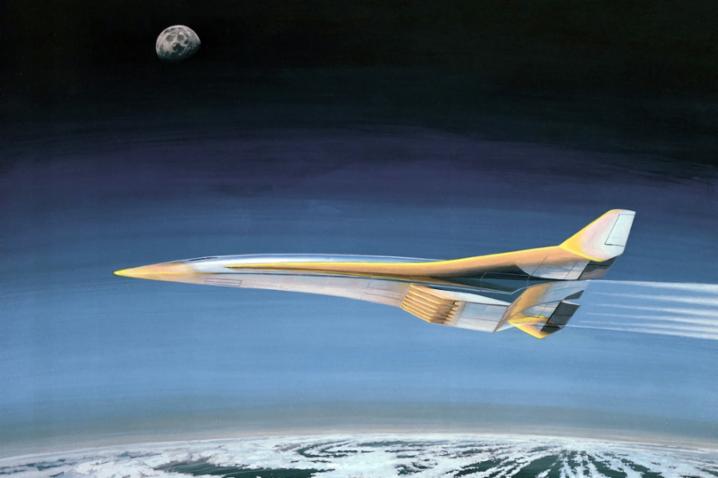What the moon landing can teach us about innovation and how to meet the challenges of the future.
From the Earth to the Moon
On 20 July 1969, astronauts Neil Armstrong and Edwin "Buzz" Aldrin became the first humans ever to set foot on the moon. This was an accomplishment set into motion by US President John F. Kennedy eight years earlier when he proclaimed the challenge of “landing a man on the moon and returning him safely to Earth.” The president said that such a challenge, at that time, was not merely technological in nature, but part of a larger “battle that is now going on around the world between freedom and tyranny… (for) the minds of men everywhere, who are attempting to make a determination of which road they should take.”

On 20 July 1969, astronauts Neil Armstrong and Edwin "Buzz" Aldrin became the first humans ever to set foot on the moon. Pictured here: Apollo 11 Commander Neil Armstrong working at an equipment storage area on the lunar module. Footage from the Apollo 11 moonwalk that was partially restored in 2009 can be seen here. © NASA
The backdrop to this historic event was a turbulent time of uncertainty, both in terms of domestic social unrest and increasing geo-political conflict. A strategic competitor, the Soviet Union, had announced its rising super-power status by unexpectedly launching the first-ever satellite, Sputnik, into orbit around the Earth in 1957. This marked the start of a “space race” that initially caught the United States flat-footed and unprepared, running embarrassingly behind for several years to come. Only through an ambitious program of innovation and investment was the United States able to edge out its competitor and win the race.
However this race was won, it was not by counting patents, comparing research expenditures, or adding up numbers of engineers and scientists. It was won by setting a clear goal that inspired individuals and companies methodically to solve the complex systems, architecture, and components problems that this goal entailed. It was solved by what has been called the triple helix of government, industry, and academia working together toward common objectives. It was solved by being clear about which challenges had to be addressed and how success could be measured in every step of the way. The key was that success could be assessed only by performance measures that were subject to a test of falsification. They either worked or they did not. They met the challenge or they did not.
The innovation imperative
We may now find ourselves in similar times. The Alliance faces rising competitors and, like the space race before it, the competition will require innovation in emerging and highly disruptive technologies. At the London Leaders’ meeting in 2019, the Alliance defined seven areas of emerging and potentially disruptive technologies that will be “highly influential for the development of future military capabilities”. They are data, Artificial Intelligence (AI), autonomy, space, hypersonics, quantum and biotechnology.
For policymakers, the question immediately arises: “Is the Alliance ahead or behind?” To answer such a question properly, the terms need to be framed in such a way that an answer can be measured and thus either falsified or proved. For example, has a member of the Alliance developed a vehicle that can safely travel at Mach 10 from New York to Paris? An answer to this question is measurable and falsifiable. The question does not ask how such a vehicle should be produced or what the design of its architecture and components should look like. Or how many patents and engineers are needed. Rather, the question has a clearly stated goal that can be used to challenge and inspire government, industry and academia, much as President Kennedy did.
Sputnik moments
In an era of constrained budgets, the Alliance must make its innovation investments wisely in order to avoid future “Sputnik moments.” But such moments become increasingly likely if it is not clear where the Alliance is behind or where it is ahead of its competitors. The approach thus far has been to track national inputs: how many patents filed, how many science and technology researchers employed, how much research and development money invested, how many new technology startups founded and funded. In other words, invest and hope for the best. These input metrics certainly have their use, but they do not reliably predict which countries will innovate in potentially important ways. Would looking at these input measures have enabled the Alliance to predict the Soviet Union’s successful Sputnik launch?

In a recent study, NATO defined seven areas of emerging and potentially disruptive technologies that will be “highly influential for the development of future military capabilities”, including data, AI, autonomy, space, hypersonics, quantum, and biotechnology.
© SoftwareONE
In fact, innovation in the space race was propelled by clear performance goals: to put a satellite safely into orbit, then a live animal, then a human, and so forth. In one of the most innovative periods in world history, there was no question who was ahead and who was behind. This experience can help us think more clearly about today. It was by setting specific performance challenges that innovation was driven relentlessly forward. The US president set the ultimate objective: to go to the moon and back. This created a cascade of intermediate milestones and sub-challenges: get astronauts into orbit, have them manoeuvre an orbiting spacecraft, do orbital rendezvous, perform extra vehicular activity, etc. Each of these were necessary conditions for getting to the moon, and, just as importantly, getting back.
Great innovations start with great problems
Instead of investing and hoping for the best, the Alliance could focus on setting audacious performance goals, and then letting the triple helix get to work. For the most pressing or significant problems, the Alliance could create formal challenges with prizes and incentives to encourage innovators to give it their best shot. This approach has worked well in the past and is currently used by a few industrial companies, government agencies, and private philanthropists to stimulate innovation. The Ansari X prize encouraged the aircraft designer Burt Rutan to successfully develop a reusable commercial space plane. In the 1920’s, the Orteig Prize encouraged a little-known airmail pilot to develop a specialized airplane and fly it solo across the perilous North Atlantic. Charles Lindbergh probably would not have risked his life if there were no prize or glory waiting for him at the other end. This is perhaps the most famous historical example (and one that, in the spirit of the Alliance, features an allied aviator bravely solving a transatlantic problem). There are many more.
Discovering the right problems to solve
A critical issue is how these challenges should be determined. This can start with academic and government institutions evaluating the current state-of-the-art for each technology or application domain. They can describe current performance frontiers and propose specific challenges to break through them. Enterprises, philanthropists, and research agencies can create and publicise challenges and prizes to encourage anyone in the triple helix to solve them.
But present day challenges are only one type of problem to be discovered. The Alliance will need to anticipate and prepare for problems likely to arise in the future, resulting from changes in technology, society, environment, and other factors. At Johns Hopkins University, we have been working on a method to “future proof” problem discovery, to ensure that problems are identified beyond the present. We seek to discover problems that may be encountered in the near and far future. Based on our research on the process of innovation, we believe this involves examining three distinct horizons of uncertainty: the probable, the plausible, and the possible. All embody different levels of uncertainty and pose different kinds of questions.
The possible looks far out into an uncertain future. It does not try to predict it, but defines alternative futures, based on long-term trends and factors of disruption. This strategic perspective seeks to discover challenges the Alliance might face in a wide range of possible scenarios. For example, what does the future of space medicine look like and what problems are likely to be encountered there?
By contrast, the plausible looks at nearer-term horizons, where the direction or rates of technological change can be anticipated or bounded. It considers the impact emerging technologies could have on the current capabilities and resources of the Alliance. For example, how can we ensure secure satellite communications if quantum computers can easily break encryption?

The US Department of Defense identified hypersonics as one of the highest priority modernisation areas, as Russia and China develop their own capable systems. Hypersonic systems are able to travel on extended flights within the upper atmosphere — 80,000 to 200,000 feet — at speeds near and above Mach 5, and they're able to manoeuvre in ways that are hard for defenders to predict.
© US Department of Defense
The probable looks at specific, well-defined problems—the kind that can be solved using traditional engineering or policy tools. Their desired outcomes are clear and measurable. Solutions either work or they do not. They are “probable,” because the likelihood of solving them can be calculated from the success rates of prior engineering and policy decisions. For instance, how do we make networked diagnostic devices to predict dangers to astronaut health and to securely communicate this to flight medics and mission control? This is typically the domain of incumbent actors within the triple helix.
The possible, plausible, and probable are interrelated. By considering all three we can build capabilities and expand our technology options to address problems that confront the Alliance now, as well as those that may arise in future. Problem discovery is dynamic and goes both ways. Thinking hard about the future lets us create challenges that can drive innovation today, and radical solutions discovered today (e.g., gene sequencing, neural networks, blockchain, etc.) create entirely new futures for us to consider and to explore.
The best way to anticipate the future is to invent it
Using this approach, the Alliance can more confidently address two critical questions: “What are the most important problems to be solved, now and in future?”, and “What specific challenges should we issue to encourage the triple helix to solve them?” In a recent NATO Review article, the head of NATO’s Innovation Unit described the many resources that the Alliance has to deliver groundbreaking innovations, including “…an abundance of world-class academic institutions, the finest scientific researchers, amazingly creative start-ups and a mature well-resourced financial eco-system.” A clear framework for discovering the most important problems to solve, and the right challenges to encourage the Alliance’s resources to solve them, is the surest way to keep the Alliance ahead of the competition in an uncertain future.
This is the sixth article of a mini-series on innovation, which focuses on technologies Allies are looking to adopt and the opportunities they will bring to the defence and security of the NATO Alliance. Previous articles:
